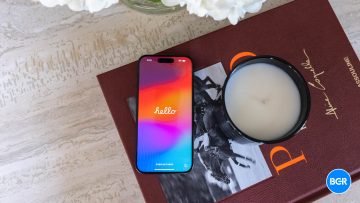With macOS 13 Ventura now available, people can use the iPhone as a webcam for the Mac. If you want to know everything you can do by combining both products, here’s how to take advantage of your iPhone camera as your Mac webcam and step up the game on video conference calls.
Apple has published everything you need to know about Continuity Camera in a new support document (via MacRumors). With your iPhone in iOS 16 and your Mac with macOS Ventura, you can enable Center Stage, Portrait mode, Studio Light, and Desk View for a superior webcam experience.
The starters
First, you need to mount your iPhone with a compatible mount and stand available. Make sure your iPhone is near your Mac, locked, stabled, and positioned with its rear cameras facing you and unobstructed.
The iPhone needs to be in landscape orientation to allow apps to choose the iPhone automatically, or in portrait orientation. Continuity Camera works wired or wirelessly to make your iPhone a webcam for the Mac.
Choosing the iPhone as webcam and microphone on the Mac
With the iPhone properly mounted, you can choose it to be your Mac webcam and microphone. You just need to open FaceTime or another app do choose from the app’s video menu this option. The same is worth it for the microphone.
Apple says you don’t need to choose your iPhone mic unless your Mac has no built-in or external mic. Your app might then choose your iPhone mic automatically.
Continuity Camera: What do you need to use Center Stage, Studio Light, Portrait Mode, or Desk View
Continuity Camera feature with macOS 13 Ventura and iOS 16 lets you expand the capabilities of your video calls with Center Stage, Studio Light, Portrait Mode, and Desk View. Here are the requirements to make your iPhone your Mac’s webcam.
Portrait mode blurs the background to keep the focus on you. It requires an iPhone XR or later
Center Stage uses your iPhone 11 or later (excludes the iPhone SE) Ultra Wide camera to keep you centered in the camera frame as you move around.
Desk View uses the Ultra Wide Camera to show your desk and your face at the same time. It requires an iPhone 11 or later, excluding the iPhone SE.
Studio Light dims the background and illuminates your face without relying on external lighting. It requires an iPhone 12 or later.
How to use Desk View with Continuity Camera?
Here are the steps to use Desk View with Continuity Camera:
- If on FaceTime, start your video call, then click the Desk View button in the upper-right corner of the video window. On a different app, click Control Center, click Video Effects, then Desk View;
- To zoom out or zoom in on your desktop, drag the onscreen control in the Desk View setup window. If you can’t get a good view of both face and desktop, try again with your iPhone in portrait orientation;
- Click Start Desk View, then share the Desk View window. If using FaceTime, the Desk View window should already be shared. If using a different app, use its screen-sharing feature to select the Desk View window for sharing.
- To stop Desk View, close the Desk View window. Or click the screen sharing button in the Desk View window.
More Apple coverage: iOS 16.1 now available, here’s why you should update








